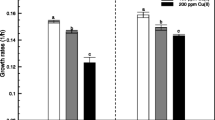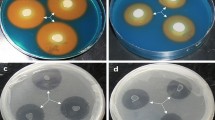Abstract
The applicability of transgenic plants and plant growth-promoting bacteria to improve plant biomass accumulation as a phytoremediation strategy at a nickel (Ni)-contaminated field site was examined. Two crops of 4-day old non-transformed and transgenic canola (Brassica napus) seedlings in the presence and absence of Pseudomonas putida strain UW4 (crop #1) or P. putida strain HS-2 (crop #1 and 2) were transplanted at a Ni-contaminated field site in 2005. Overall, transgenic canola had increased growth but decreased shoot Ni concentrations compared to non-transformed canola, resulting in similar total Ni per plant. Under optimal growth conditions (crop #2), the addition of P. putida HS-2 significantly enhanced growth for non-transformed canola. Canola with P. putida HS-2 had trends of higher total Ni per plant than canola without P. putida HS-2, indicating the potential usefulness of this bacterium in phytoremediation strategies. Modifications to the planting methods may be required to increase plant Ni uptake.



Similar content being viewed by others
Abbreviations
- ACC:
-
1-Aminocyclopropane-1-carboxylate
- C:
-
Control or non-transformed canola
- T:
-
Transgenic canola
References
Belimov AA, Hontzeas N, Safronova VI, Demchinskaya SV, Piluzza G, Bullitta S, Glick BR (2005) Cadmium-tolerant plant growth-promoting bacteria associated with the roots of Indian mustard (Brassica juncea L. Czern.). Soil Biol Biochem 37:241–250
Burd GI, Dixon DG, Glick BR (1998) A plant growth-promoting bacterium that decreases nickel toxicity in seedlings. Appl Environ Microb 64:3663–3668
Clemens S, Palmgren MG, Krämer U (2002) A long way ahead: understanding and engineering plant metal accumulation. Trends Plant Sci 7:309–315
Elmayan T, Tepfer M (1995) Evaluation in tobacco of the organ specificity and strength of the rolD promoter, domain-A of the 35S promoter and the 35S2 promoter. Trans Res 4:388–396
Environment Canada (2005a) Daily Data Report for May (2005) [online]. Available from http://www.climate.weatheroffice.ec.gc.ca/climateData/dailydata_e.html?timeframe = 2&Prov = CA&StationID = 4671&Year = 2005&Month = 5&Day = 4 [cited 27 February (2006)]
Environment Canada (2005b) Daily Data Report for June (2005) [online]. Available from http://www.climate.weatheroffice.ec.gc.ca/climateData/dailydata_e.html?timeframe = 2&Prov = CA&StationID = 4671&Year = 2005&Month = 6&Day = 4 [cited 27 February (2006)]
Environment Canada (2005c) Daily Data Report for August (2005) [online]. Available from http://www.climate.weatheroffice.ec.gc.ca/climateData/dailydata_e.html?timeframe = 2&Prov = CA&StationID = 4671&Year = 2005&Month = 8&Day = 4 [cited 27 February (2006)]
Environment Canada (2005d) Daily Report for September (2005) [online]. Available from http://www.climate.weatheroffice.ec.gc.ca/climateData/dailydata_e.html?timeframe = 2&Prov = CA&StationID = 4671&Year = 2005&Month = 9&Day = 4 [cited 27 February (2006)]
Fargašová A, Beinrohr B (1998) Metal-metal interactions in accumulation of V5+, Ni2+, Mo6+, Mn2+ and Cu2+ in under- and above-ground parts of Sinapis alba. Chemosphere 36:1305–1317
Farwell AJ, Vesely S, Nero V, Rodriguez H, McCormack K, Shah S, Dixon DG, Glick BR (2006) Tolerance of transgenic canola plants (Brassica napus) amended with plant growth-promoting bacteria to flooding stress at a metal-contaminated field site. Environ Pollut (submitted)
Frank R, Stonefield KI, Suda P (1982) Impact of nickel contamination on the production of vegetables on an organic soil, Ontario, Canada, 1980–1981. Sci Total Environ 26:41–65
Glick BR, Karaturovic DM, Newell PC (1995) A novel procedure for rapid isolation of plant-growth promoting pseudomonads. Can J Microbiol 41:533–536
Grichko VP, Filby B, Glick BR (2000) Increased ability of transgenic plants expressing the bacterial enzyme ACC deaminase to accumulate Cd, Co, Cu, Ni, Pb, and Zn. J Biotechnol 81:45–53
Grichko VP, Glick BR (2001) Amelioration of flooding stress by ACC deaminase-containing plant growth-promoting bacteria. Plant Physiol. Biochem 39:11–17
Hontzeas N, Richardson AO, Belimov A, Safranova V, Abu-Omar MM, Glick BR (2005) Evidence for horizontal gene transfer (HGT) of ACC deaminase genes. Appl Environ Microbiol 71:7556–7558
Kashem MA, Singh BR (2001a) Metal availability in contaminated soils: I. Effects of flooding and organic matter on changes in Eh, pH and solubility of Cd, Ni and Zn. Nutr Cycl Agroecosys 61:247–255
Kashem MA, Singh BR (2001b) Metal availability in contaminated soils: II. Uptake of Cd, Ni and Zn in rice plants grown under flooded culture with organic matter addition. Nutr. Cycl. Agroecosys 61:257–266
Krämer U, Chardonnens AN (2001) The use of transgenic plants in the bioremediation of soils contaminated with trace elements. Appl Microbiol Biotechnol 55:61–672
Kukier U, Chaney RL (2001) Amelioration of nickel phytotoxicity in muck and mineral soils. J Environ Qual 30:1949–1960
Kukier U, Chaney RL (2004) In situ remediation of nickel phytotoxicity for different plant species. J Plant Nutr 27:465–495
Lasat MM (2002) Phytoextraction of toxic metals: A review of biological mechanisms. J Environ Qual 31:109–120
Lindsay WL, Norvell WA (1978) Development of DTPA test for Zn, Fe, Mn and Cu. Soil Sci Soc Am J 42:421–28
Mayak S, Tirosh T, Glick BR (2004a) Plant growth-promoting bacteria that confer resistance in tomato plants to salt stress. Plant Physiol. Biochem 42:565–572
Mayak S, Tirosh T, Glick BR (2004b) Plant growth-promoting bacteria that confer resistance to water stress in tomatoes and peppers. Plant Sci 166:525–530
McGrath SP, Zhao FJ, Lombi E (2001) Plant and rhizosphere processes involved in phytoremediation of metal-contaminated soils. Plant Soil 232:207–214
McIlveen WD, Negusanti JJ (1994) Nickel in the terrestrial environment. Sci Total Environ 148:109–138
Nie L, Shah S, Rashid A, Burd GI, Dixon DG, Glick BR (2002) Phytoremediation of arsenate contaminated soil by transgenic canola and the plant growth-promoting bacterium Enterobacter cloacae CAL2. Plant Physiol Biochem 40:355–361
Reed MLE, Glick BR (2005) Growth of canola (Brassica napus) in the presence of plant growth-promoting bacteria and either copper or polycyclic aromatic hydrocarbons. Can J Microbiol 51:1061–1069
Reed MLE, Warner BG, Glick BR (2005) Plant growth-promoting bacteria facilitate the growth of the common reed Phragmites australis in the presence of copper or polycyclic aromatic hydrocarbons. Curr Microbiol 51:425–429
Robison MM, Shah S, Tamot B, Pauls KP, Moffatt BA, Glick BR (2001) Reduced symptoms of Verticillium wilt in transgenic tomato expressing a bacterial ACC deaminase. Mol Plant Pathol 2:135–145
Robinson BH, Brooks RR, Clothier BE (1999) Soil amendments affecting nickel and cobalt uptake by Berkheya coddii: potential use for phytomining and phytoremediation. Ann Bot 84:689–694
Rodriguez H, Vesely S, Shah S, Glick BR (2006) Isolation and characterization of nickel resistant Pseudomonas strains and their effect on the growth of non-transformed and transgenic canola plants. Curr Microbiol (submitted)
Sergeeva E, Shah S, Glick BR (2006) Tolerance of transgenic canola expressing a bacterial ACC deaminase gene to high concentrations of salt. World J Microbiol Biotechnol 22:277–282
Shah S, Li J, Moffatt BA, Glick BR (1997) ACC deaminase genes from plant growth-promoting rhizobacteria. In: Ogoshi A, Kobayashi K, Hemma Y, Kodema F, Kondo N, Akino S (Eds.) Plant growth-promoting rhizobacteria. Present status and future prospects. OECD, Paris, pp 320–324
Shah S, Li J, Moffatt BA, Glick BR (1998) Isolation and characterization of ACC deaminase genes from two different plant growth-promoting rhizobacteria. Can J Microbiol 44:833–843
Stearns JC, Glick BR (2003) Transgenic plants with altered ethylene biosynthesis or perception. Biotechnol Adv 21:193–210
Stearns JC, Shah S, Greenberg BM, Dixon DG, Glick BR (2005) Tolerance of transgenic canola expressing 1-aminocyclopropane-1-carboxylic acid deaminase to growth inhibition by nickel. Plant Physiol Biochem 43:701–708
Wang C, Knill E, Glick BR, Défago G (2000) Effects of transferring 1-aminocyclopropane-1-carboxylic acid (ACC) deaminase genes into Pseudomonas fluorscens strain CHA0 and its gacA derivative CHA96 on their growth-promoting and disease-suppressive capacities. Can J Microbiol 46:898–907
Acknowledgments
This project was funded by a Strategic Grant from the Natural Sciences and Engineering Research Council of Canada to B.R. Glick. We would like to thank Eric Azzopardi and Maria Bellantino-Perco for site co-ordination, Brian Emburgh and Co. and all the individuals from the University of Waterloo for field support. Special thanks to Rick Playle (Wilfrid Laurier University) for the use of the AA for nickel analysis. The use of transgenic canola (Confined Research Field Trial Application 05-UOW1-272-CAN), P. putida UW4 (Research Authorization #16578RN) and P. putida HS-2 (Research Authorization #16661RS) were authorized by the Plant Products Directorate, Canadian Food Inspection Agency, Ottawa, ON, Canada.
Author information
Authors and Affiliations
Corresponding author
Rights and permissions
About this article
Cite this article
Farwell, A.J., Vesely, S., Nero, V. et al. The use of transgenic canola (Brassica napus) and plant growth-promoting bacteria to enhance plant biomass at a nickel-contaminated field site . Plant Soil 288, 309–318 (2006). https://doi.org/10.1007/s11104-006-9119-y
Received:
Accepted:
Published:
Issue Date:
DOI: https://doi.org/10.1007/s11104-006-9119-y




